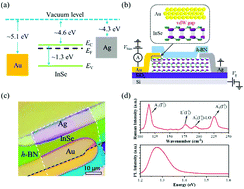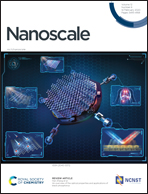Au–InSe van der Waals Schottky junctions with ultralow reverse current and high photosensitivity†
Abstract
The Schottky junction, composed of a rectifying metal–semiconductor interface, is an essential component for microelectronic and optoelectronic devices. However, due to the considerable reverse tunneling current, typical Schottky junctions cannot be widely applied in devices requiring high signal-to-noise ratios, such as photodetectors with high detectivity. Here, a van der Waals (vdW) Schottky junction is constructed by mechanically stacking a gold (Au) electrode onto a multilayer indium selenide (InSe) nanosheet, which shows an ultralow reverse current in sub-picoamperes and an excellent rectification ratio exceeding 106 at room temperature. The reverse current, which corresponds to the thermionic emission transport model, is independent of the applied reverse bias. As a result, the Au–InSe vdW Schottky junction device can function as an ultrasensitive photodetector with a photodetectivity over 2.4 × 1015 Jones, corresponding to a photoresponsivity of 853 A W−1 and a light on/off ratio exceeding 1 × 107. The work offers an idea for investigating electronic and optoelectronic devices with high signal-to-noise ratios based on vdW Schottky junctions.



 Please wait while we load your content...
Please wait while we load your content...